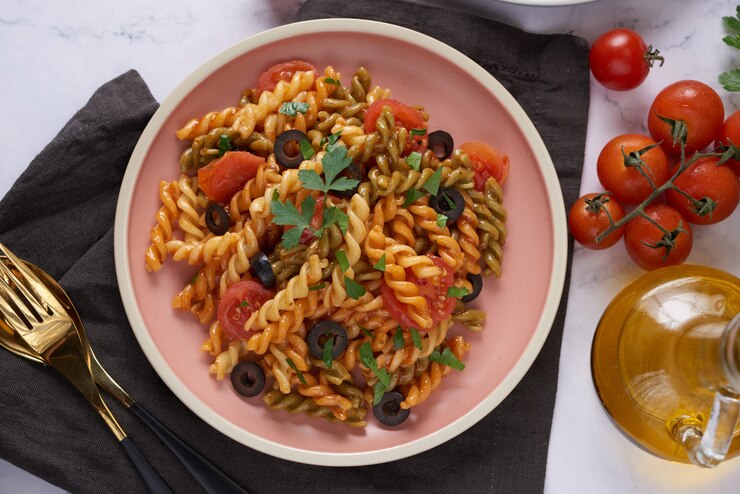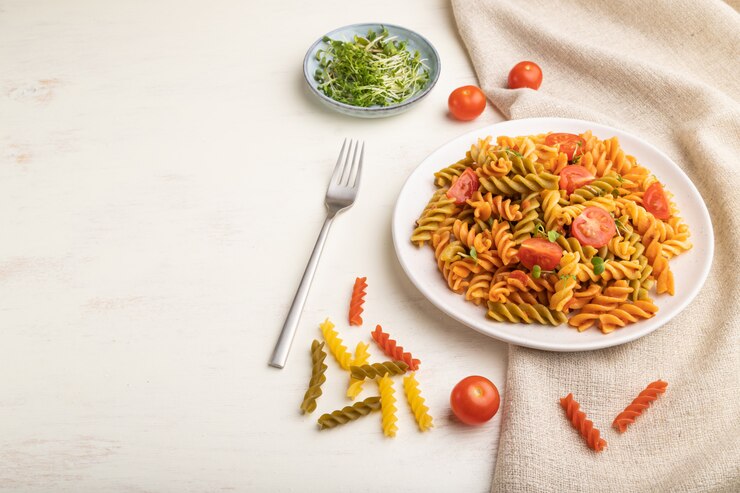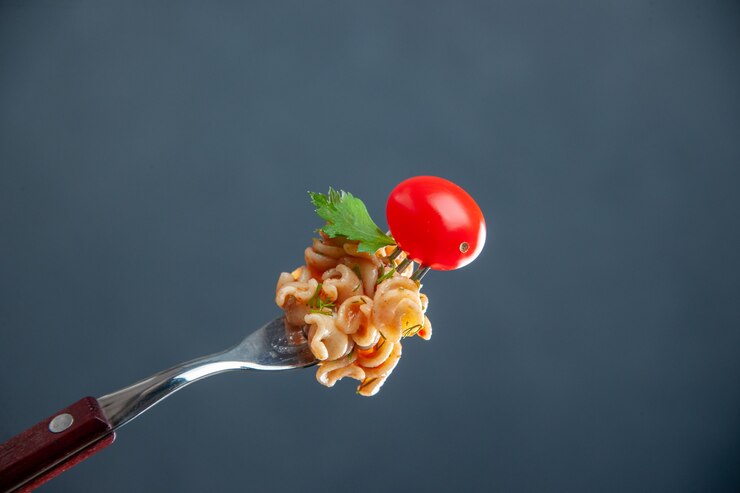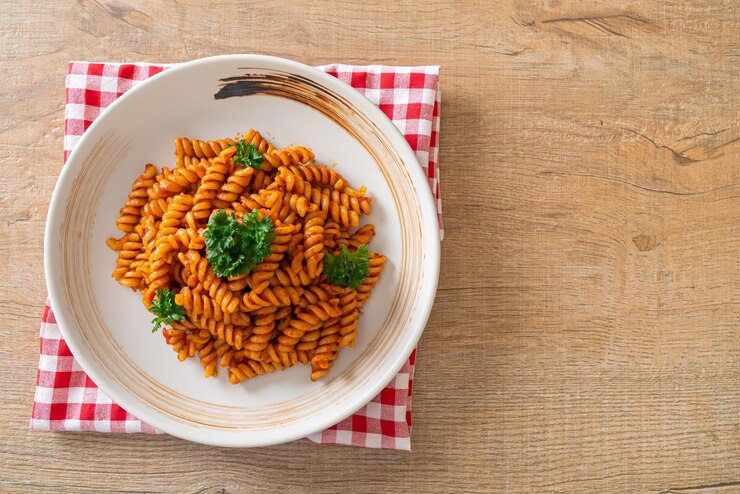Looking for a romantic yet effortless Valentine’s Day dinner? Ditch the crowded restaurants and impress your loved one with a vibrant and flavorful homemade meal. This isn’t just any pasta dish; we’re talking about a luscious vegan tomato fusilli pasta, a comforting and satisfying dish that’s perfect for a cozy night in. This recipe offers a delightful twist on classic comfort food, proving that plant-based meals can be both elegant and incredibly delicious.
In this article, you’ll discover a simple yet elegant tomato fusilli pasta recipe, complete with a rich and creamy tomato fusilli pasta sauce. Whether you’re a seasoned chef or a kitchen novice, this fusilli pasta recipe is easy to follow and adaptable to your preferences. While this specific recipe isn’t Indian style, we’ll touch on ways you could incorporate Indian-inspired spices and flavors, giving you the tools to create your own unique fusilli pasta recipe Indian style. Get ready to fall in love with this creamy tomato fusilli pasta!

Ingredients:
- 1 pound fusilli pasta
- 1 tablespoon olive oil
- 1 medium onion, finely chopped
- 2 cloves garlic, minced
- 1 inch ginger, grated
- 1 green chili, finely chopped (optional, adjust to taste)
- 1 teaspoon garam masala
- 1 teaspoon cumin powder
- 1/2 teaspoon turmeric powder
- 1/4 teaspoon red chili powder (adjust to taste)
- 1 (28 ounce) can crushed tomatoes
- 1 cup vegetable broth
- 1/2 cup coconut milk (for creaminess)
- 1/4 cup chopped fresh cilantro
- Salt and pepper to taste
- Optional: 1/2 cup frozen peas or other vegetables
Preparation Time: 15 minutes (chopping vegetables, measuring spices)
Cooking Time: 30 minutes (sautéing, simmering sauce, cooking pasta)
Total Time: 45 minutes
Serving Size: This recipe yields approximately 6 servings (about 1.5 cups per serving).
Estimated Cost (US Market):
It’s tricky to give an exact cost due to regional price differences and varying brand prices. However, here’s a rough estimate based on average US grocery store prices:
- Pasta (1 lb): $1.50 – $2.50
- Onion: $0.50 – $1.00
- Garlic: $0.50 – $1.00
- Ginger: $0.50 – $1.00
- Green Chili: $0.25 – $0.50
- Spices (garam masala, cumin, turmeric, chili powder): $1.00 – $2.00 (assuming you have some on hand; buying new can be more expensive initially but you’ll have them for future use)
- Canned Tomatoes (28 oz): $1.50 – $2.50
- Vegetable Broth: $1.00 – $2.00
- Coconut Milk: $2.00 – $3.00
- Cilantro: $0.50 – $1.00
- Optional (peas): $1.00 – $1.50
Total Estimated Cost: $10.75 – $18.00
Cost per Serving: $1.79 – $3.00 (approximately)
Important Notes on Cost:
- Buying spices in bulk is generally more economical than buying small jars.
- Using store-brand ingredients can often save money.
- If you already have some of the pantry staples (like spices, oil, or broth), the cost will be lower.
- Prices can vary depending on where you live and the time of year.
This cost estimate provides a general idea of the affordability of this recipe. It’s a relatively budget-friendly meal, especially considering it makes a good amount of servings.
Step 1: Sauté Aromatics
Heat the olive oil in a large pan or pot over medium heat. Add the chopped onion and sauté until softened and translucent, about 5 minutes. Then, add the minced garlic, grated ginger, and green chili (if using) and sauté for another minute until fragrant. Be careful not to burn the garlic.
Step 2: Bloom the Spices
Add the garam masala, cumin powder, turmeric powder, and red chili powder to the pan. Sauté for about 30 seconds, stirring constantly, until the spices become fragrant. This process is called “blooming” the spices and helps to release their full flavor. Be careful not to burn the spices.
Step 3: Create the Tomato Sauce
Pour in the crushed tomatoes and vegetable broth. Bring the mixture to a simmer, then reduce the heat to low, cover, and let it simmer for 15-20 minutes, allowing the flavors to meld together. This simmering time allows the sauce to thicken slightly and the spices to fully infuse the tomatoes.
Step 4: Add Coconut Milk and Vegetables (Optional)
Stir in the coconut milk to create a creamy and rich sauce. If using, add frozen peas or other vegetables at this stage and cook until they are heated through. Season with salt and pepper to taste.
Step 5: Cook the Pasta
While the sauce is simmering, cook the fusilli pasta according to package directions until al dente. Reserve about 1 cup of pasta water before draining.
Step 6: Combine Pasta and Sauce
Add the cooked pasta to the pan with the tomato sauce. Toss well to coat the pasta evenly. If the sauce is too thick, add a little of the reserved pasta water to achieve the desired consistency.
Step 7: Garnish and Serve
Garnish with fresh cilantro and serve hot. This creamy tomato fusilli pasta with Indian-inspired spices is a delicious and comforting meal that’s perfect for any occasion.

Storage and Reheating Instructions
Here’s how to store, keep, and reheat leftover Creamy Tomato Fusilli Pasta with Indian-Inspired Spices for the best taste:
Storage:
- Cool Completely: Allow the leftover pasta to cool down to room temperature before storing it. This prevents condensation from forming inside the container, which can lead to bacterial growth and a soggy texture.
- Airtight Containers: Transfer the cooled pasta to airtight containers. This prevents it from drying out and absorbing odors from the refrigerator. Use shallow containers if possible, as this helps the pasta cool down faster and more evenly.
- Portioning (Optional): If you plan to eat the leftovers over several days, consider portioning them into individual containers for easy grab-and-go meals.
When stored properly in the refrigerator, leftover Creamy Tomato Fusilli Pasta with Indian-Inspired Spices will last for 3-4 days. It’s best to consume it within this timeframe for optimal taste and quality. After 4 days, the texture may start to deteriorate, and there’s an increased risk of bacterial growth.
Reheating Methods:
Reheating pasta can sometimes lead to a dry or mushy texture. Here are the best methods to maintain the pasta’s quality:
Stovetop (Recommended): This is the best method for reheating pasta while maintaining its creamy texture.
- Place the desired amount of pasta in a saucepan or skillet.
- Add a splash of water or vegetable broth (about 1-2 tablespoons per serving) to help loosen the sauce and prevent the pasta from drying out.
- Heat over medium-low heat, stirring occasionally, until heated through. Be careful not to overheat, as this can make the pasta mushy.
Microwave (Quick but Less Ideal): The microwave is a quick option, but it can sometimes result in uneven heating and a drier texture.
- Place the pasta in a microwave-safe dish.
- Add a splash of water or vegetable broth (about 1-2 tablespoons per serving).
- Cover the dish loosely with a microwave-safe lid or plastic wrap (vented).
- Microwave in 30-second intervals, stirring in between, until heated through. Avoid overcooking.
Oven (For Larger Quantities): This method is best for reheating larger amounts of pasta, but it takes longer.
- Preheat your oven to 350°F (175°C).
- Place the pasta in an oven-safe dish.
- Add a splash of water or vegetable broth (about 1/4 cup for a larger dish).
- Cover the dish with foil.
- Bake for 15-20 minutes, or until heated through.
Tips for Reheating:
- Don’t Overheat: Overheating is the main culprit for dry or mushy pasta. Reheat gently and just until heated through.
- Add Liquid: Adding a little water or broth helps to rehydrate the sauce and prevent the pasta from drying out.
- Stir Frequently: Stirring while reheating ensures even heating and prevents the pasta from sticking together.
By following these storage and reheating tips, you can enjoy your leftover Creamy Tomato Fusilli Pasta with Indian-Inspired Spices almost as much as the first time!

Nutritional Information
Here’s an estimated nutritional breakdown per serving based on common ingredients and typical serving sizes (about 1.5 cups). This is an approximation and should not be considered definitive.
Estimated Nutrition Facts per Serving (Approximately 1.5 cups):
| Nutrient | Amount (Approximate) | % Daily Value* (Approximate) |
| Calories | 400-450 | 20-23% |
| Total Fat | 15-20g | 23-31% |
| Saturated Fat | 8-12g | 40-60% |
| Cholesterol | 0mg | 0% |
| Sodium | 500-700mg | 21-29% |
| Total Carbohydrate | 60-70g | 20-23% |
| Dietary Fiber | 8-10g | 32-40% |
| Total Sugars | 10-15g | |
| Added Sugars | 0-5g | |
| Protein | 10-12g | 20-24% |
| Vitamin A | 15-20% | |
| Vitamin C | 20-25% | |
| Calcium | 10-15% | |
| Iron | 15-20% |
Percent Daily Values are based on a 2,000 calorie diet. Your daily values may be higher or lower depending on your calorie needs.
Important Considerations that Affect Nutritional Value:
- Coconut Milk: The fat content will vary depending on whether you use full-fat or light coconut milk. Full-fat will significantly increase the saturated fat and calorie count.
- Added Oil: The amount of olive oil used will affect the fat and calorie content.
- Vegetables: Adding more vegetables will increase fiber and micronutrients, while slightly altering the calorie and carbohydrate content.
- Pasta Type: Different types of pasta have slightly different nutritional profiles. Whole wheat pasta will increase fiber content.
- Sodium Content of Ingredients: Using low-sodium broth or canned tomatoes will significantly reduce the sodium content.
To get a more accurate nutritional analysis:
- Use a nutrition calculator website or app (like MyFitnessPal, Cronometer, or Verywell Fit).
- Input the exact brands and quantities of each ingredient you use in the recipe.
This table provides a general idea, but using a nutrition calculator with your specific ingredients is the best way to get accurate information.
Dietary Information
The Creamy Tomato Fusilli Pasta with Indian-Inspired Spices recipe, as written, is suitable for the following diet:
- Vegan: Yes, this recipe is entirely plant-based, containing no animal products.
However, it is not suitable for the following diets as written:
- Gluten-Free: No, traditional fusilli pasta is made from wheat, which contains gluten.
- Keto: No, pasta is high in carbohydrates, which are restricted on the ketogenic diet. The sauce itself could be adapted to be more keto-friendly, but the pasta would need to be substituted entirely.
Modifications for Other Diets:
Gluten-Free: To make this recipe gluten-free, simply substitute the regular fusilli pasta with a gluten-free alternative, such as gluten-free fusilli made from rice, corn, quinoa, or a blend of gluten-free flours.
Keto (Significant Modifications Required): To make this recipe keto-friendly, you would need to make substantial changes:
The pasta would need to be replaced with a low-carb alternative, such as:
- Zucchini noodles (zoodles)
- Shirataki noodles (made from konjac yam)
- Cauliflower rice
While the sauce itself is relatively low in carbs, you would want to ensure no added sugars are in the canned tomatoes or broth. You could also add more healthy fats like olive oil or coconut oil to increase the fat content.
Therefore, with a simple substitution, this recipe can be made gluten-free. However, it requires significant changes to become keto-friendly.

The History of Tomato Fusilli Pasta
The Creamy Tomato Fusilli Pasta with Indian-Inspired Spices doesn’t have a long, established history like traditional Italian pasta dishes. It’s a modern fusion creation, blending the familiar comfort of creamy tomato pasta with the aromatic depth of Indian cuisine. The concept likely emerged from the increasing popularity of global flavors and the desire for culinary experimentation.
While tomato-based pasta sauces have Italian origins, the addition of spices like garam masala, cumin, turmeric, and chili powder clearly draws inspiration from Indian cooking traditions. Coconut milk, used for creaminess, is also a staple in many Indian dishes. This fusion likely developed in home kitchens and modern restaurants as chefs and home cooks sought to create unique and exciting flavor combinations, bridging culinary traditions and offering a new take on classic comfort food. It represents a contemporary approach to cooking, embracing cross-cultural influences to create something new and delicious.
What sauce goes best with fusilli pasta?
Fusilli’s corkscrew shape and ridges make it a fantastic pasta for capturing and holding onto a variety of sauces. Here are some of the sauces that go best with fusilli pasta:
- Tomato-based sauces: Whether it’s a simple marinara, a rich Bolognese, or a chunky vegetable sauce, the acidity and sweetness of tomatoes complement the hearty texture of fusilli. The spirals and ridges of the pasta trap the sauce beautifully, ensuring every bite is flavorful.
- Pesto: This vibrant green sauce made with basil, pine nuts, garlic, Parmesan cheese, and olive oil is a classic pairing with fusilli. The pesto clings to the pasta’s twists and provides a burst of fresh, herbaceous flavor.
- Creamy sauces: Alfredo, a creamy white sauce made with butter, cream, and Parmesan cheese, is a luxurious choice for fusilli. The sauce coats the pasta evenly, creating a rich and indulgent dish. Other creamy sauces, like those with a base of béchamel or cream cheese, also work well.
- Oil-based sauces: Light and flavorful oil-based sauces, such as those with garlic, herbs, and chili flakes, are a good option for fusilli. The pasta’s shape allows it to hold onto the oil and seasonings, creating a simple yet satisfying dish.
- Sauces with chunks: Fusilli is also great with sauces that have chunks of vegetables, meat, or seafood. The pasta’s spirals help to hold onto these ingredients, ensuring they are evenly distributed throughout the dish.
Ultimately, the best sauce for fusilli pasta depends on your personal preferences. However, the sauces listed above are some of the most popular and well-suited pairings.
What is fusilli pasta best for?
Fusilli pasta, with its distinctive spiral or corkscrew shape, is incredibly versatile and works well in a variety of dishes. Here are some of the things fusilli is best for:
The twists and grooves of fusilli are excellent at trapping sauces, whether they’re smooth or chunky. This makes it a great choice for:
- Hearty meat sauces: Like Bolognese or ragu, where the sauce clings to the pasta.
- Creamy sauces: Such as Alfredo or cheese sauces, which coat the pasta evenly.
- Pesto: The spirals capture the pesto beautifully, maximizing the flavor in each bite.
- Vegetable-based sauces: Where the pasta holds onto the small pieces of vegetables.
Fusilli’s shape and texture hold up well when chilled and tossed with dressings, making it a popular choice for pasta salads. It can be paired with:
- Vinaigrette-based dressings: The pasta absorbs the dressing and remains flavorful.
- Creamy dressings: Like mayonnaise-based dressings, which coat the pasta nicely.
- A variety of ingredients: Such as vegetables, cheeses, meats, and olives.
Baked Pasta Dishes: Fusilli’s shape also works well in baked pasta dishes like casseroles. The pasta holds its shape during baking and provides a satisfying texture.
Soups: While less common than some other pasta shapes, fusilli can add a nice texture to soups, especially thicker, heartier ones.
Are fusilli pastas healthy?
Fusilli pasta, especially whole wheat varieties, can be a healthy part of a balanced diet. It provides complex carbohydrates for energy, fiber for digestion, and some protein, while being low in fat and sodium. The healthiness of a fusilli dish largely depends on the accompanying sauce and ingredients. By making smart choices, you can enjoy fusilli as part of a nutritious and satisfying meal.
What is fusilli pasta made of?
Fusilli pasta is primarily made from durum wheat semolina. This is a coarse, purified wheat middlings of durum wheat. Durum wheat is a hard, high-protein wheat variety specifically chosen for pasta making. Semolina gives pasta its characteristic golden color, firm texture, and ability to hold its shape during cooking.
Sometimes, you might find fusilli made with whole wheat flour that includes the entire wheat kernel (bran, germ, and endosperm), resulting in a pasta with higher fiber content and a slightly nutty flavor.
For those with dietary restrictions, fusilli can also be made from:
- Rice flour (for gluten-free pasta)
- Corn flour (for gluten-free pasta)
- A blend of gluten-free flours (like rice, corn, quinoa, or chickpea flour)
In its most basic form, fusilli is simply durum wheat semolina and water. However, some manufacturers may add small amounts of other ingredients like vitamins and minerals to enrich the nutritional value of the pasta.
So, the key ingredient is durum wheat semolina, which gives fusilli its distinct texture and cooking properties.

Final Thoughts
The beauty of modern cuisine lies in its ability to blend traditions and create something entirely new. This Creamy Tomato Fusilli Pasta with Indian-Inspired Spices is a testament to that philosophy. It’s a dish that celebrates the familiar comfort of Italian pasta while embracing the vibrant flavors of India. We encourage you to experiment with the spices, adjust the heat to your liking, and make this recipe your own. It’s a culinary adventure worth taking.









